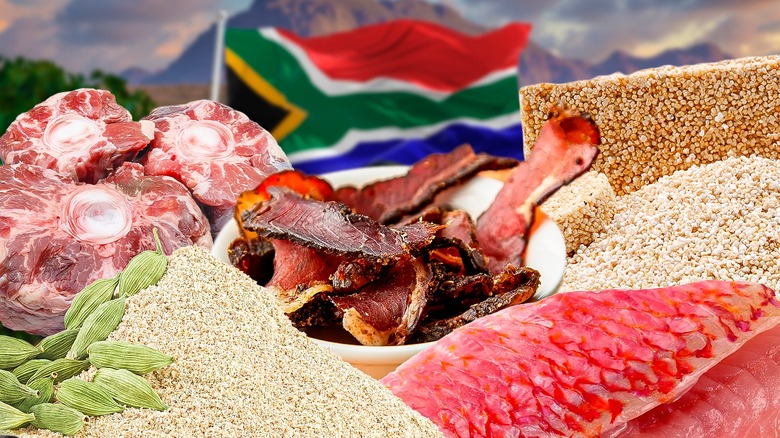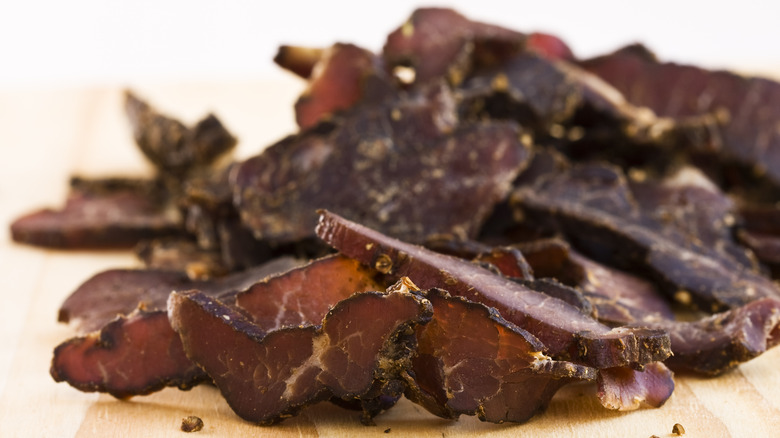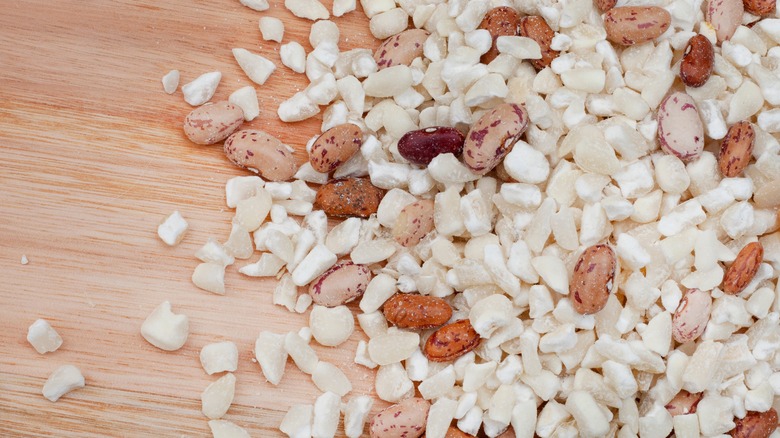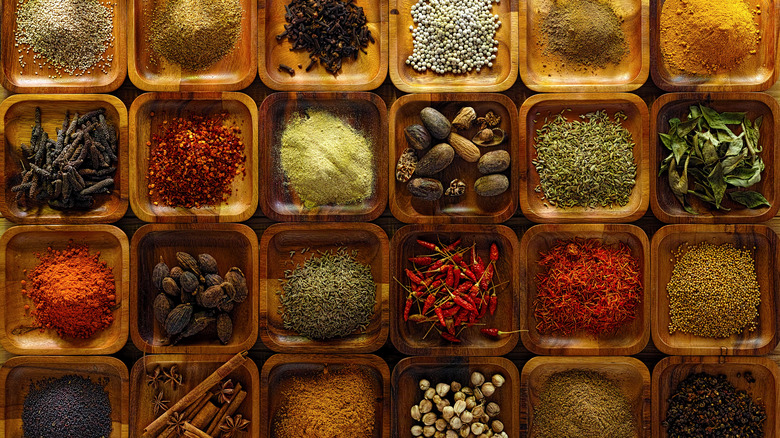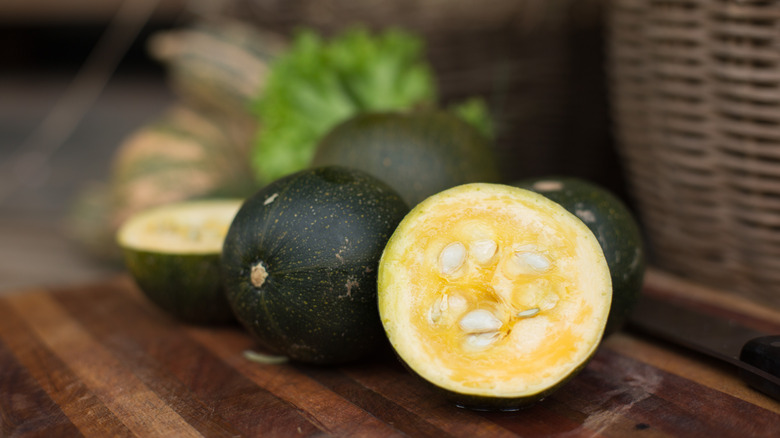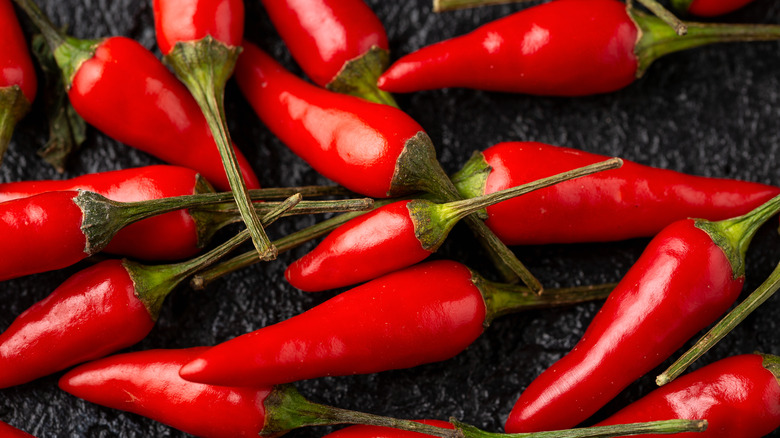12 Essential Ingredients For South African Cooking, According To An Expert
If South Africa isn't on your traveling bucket list, go add it right now. From Africa's Big Five in Kruger National Park, to penguins (yes, penguins) on the coast of Cape Town, this diverse and beautiful country truly has something for everyone. There's striking contemporary art, world-renowned vineyards ... and the food!
Simply put, South Africa has a rich and exciting culinary tradition that will keep your senses buzzing — and your stomach full. You can head to Nando's for peri-peri chicken, feast on abundant local seafood, or join the locals for a sunset braai and a glass of Pinotage (which, they'll tell you, is the best wine in the world).
Of course, if a trip isn't in the cards, you can always bring the cuisine to you. And while we've had the pleasure of enjoying some spectacular meals throughout South Africa, eating does not an expert make. Luckily, we were able to speak with chef Pierre Van Zyl — the senior chef lecturer at the Institute of Culinary Arts in Banhoek, Stellenbosch, South Africa — who walked us through everything you'll need to bring some of South Africa's flavors into your kitchen. Here are 12 essential ingredients for South African cooking according to an expert.
South Africa's culinary tradition is defined by diversity and history
Home to UNESCO's Cradle of Humankind site, South Africa's culinary tradition has been evolving for over 100,000 years — with various cultural influences. "Each one of these cultures added to the food we eat and ... have come to love," chef Van Zyl told us, beginning with hunter-gatherers known as the Khoisan.
The Khoisan ate a largely vegetarian diet that included wild berries, roots, leaves, and tubers — some of which remain a part of modern South African cuisine. In 1652, Dutch colonizers led by Jan Van Riebeeck introduced the practice of domesticated livestock, which increased the presence of various meats in the local diet. Van Riebeeck also brought grape vines, and planted vineyards to create the early beginnings of South Africa's now-thriving wine production.
Later, the enslaved Malaysian people from Madagascar brought a number of spices — and, as Pierre Van Zyl noted, spices were akin to currency at that time. These ingredients were absorbed into the cuisine, as well, and the food of Cape Malay (the region's Muslim community) continues to feature curries and samosas spiced with cardamom, cloves, and chili.
Native plants
According to chef Pierre Van Zyl, a number of "forgotten" traditional ingredients are now "being researched and used a lot more" in modern South African cooking — a list that includes rooibos. This native bush's leaves have been used as a unique tea for centuries. It is usually dried, crushed, and then fermented (which creates its red color and iconic flavor). With a sweet vanilla and caramel profile to go with its robust scent, rooibos leaves can add dimension to sweets and desserts.
Kapokbos — another indigenous shrub (one used as a natural medication in the region) — is often referred to as wild rosemary. It can be a seasoning or a garnish, and may be featured in savory sauces, on focaccia, or combined with coarse salt to create a seasoning. Kapokbos is hard to find outside of South Africa, though, so if you're cooking at home somewhere in the U.S., use fresh rosemary instead.
Additionally, there's Aasobs, a plant historically utilized by local fishermen to rid their hands of the smell of bait after a trip. The "elegant aroma" of aasobs is reminiscent of chamomile, with Van Zyl noting the herb works especially well when mixed with egg whites, and baked over fish.
Biltong seasonings
Biltong has become more popular in the United States in recent years. But the traditional South African dried meat snack differs from jerky because it features the additional step of curing, is air-dried rather than cooked, and utilizes a "very specific spice mixture," as noted by Pierre Van Zyl.
Biltong's seasoning mixture combines toasted coriander seeds, brown sugar, and black pepper with Worcestershire sauce and brown vinegar. The use of coriander is a notable difference from other jerky seasonings — and evidence of the Malaysian influence on South African cuisine. The addition of vinegar ensures it remains particularly tender compared to other types of jerky, which may explain why biltong is often shredded instead of sliced.
Additionally, biltong seasoning isn't limited solely to dried beef. It can be used as a marinade for lamb ribs, according to Van Zyl, who suggests you let the meat soak in the biltong mixture for "12 hours" before cooking. You can also use it to season pre-ground sausages for a classic South African flavor profile.
Mrs. H.S. Ball's Chutney
Mrs. H.S. Ball's chutney is ubiquitous in South Africa, so having a jar of the condiment in your pantry is absolutely necessary if you're hoping to bring a taste of South Africa into your kitchen. The original Mrs. H.S. Ball's chutney is made with dried peaches and apricots, and is similar to chutneys associated with Indian cuisine. It's a sweet, tangy ingredient that can be used to marinate chicken, sauce casseroles, or create a pink dipping sauce when combined with mayonnaise and ketchup (consider this South Africa's answer to fry sauce).
To make the most of Mrs. Ball's chutney, make what Chef Pierre Van Zyl considers South Africa's national sandwich: the braaibroodjie. Made with two slices of bread slathered with the condiment, the braaibroodjie includes sliced onion, tomato, and cheese. Van Zyl recommends cooking it over low coals, as it "is just next level" when prepared this way (and here's your reminder to make epic grilled cheese the next time you barbecue). Since Mrs. Ball's can be purchased online, and comes in spicier varieties that include jalapeños and other chilis? Be sure to stock up.
Corn meal
Corn — or maize — was first introduced to Africa (from the New World) by European colonizers in the 17th century. Today, it's a staple food in many parts of Africa, and corn meal — or maize meal — appears in a variety of traditional South African dishes.
Not unlike corn meals you'd find at an American grocery store, maize meal is available in a variety of textures in South Africa. Samp, for instance, is made from white corn kernels, which are dried, then very coarsely cracked or chopped. Since samp "needs to absorb a lot of moisture," as described by Pierre Van Zyl, it's best to soak it before cooking. One popular use is in the hearty, slow-cooked stew called samp and beans.
Maize meal, on the other hand, is more fine. It's often cooked into porridge for breakfast, into bread, or as the base of paptert (a classic dish where soft maize meal is layered with tomato sauce and cheese). To create these dishes at home, coarsely chop dried white hominy to replace South African samp, or use grits to replace maize meal.
Sugar beans
Beans are a prominent part of the South African diet, and the most popular variety is the sugar bean. These red-speckled beans grow well in the arid climate, and are high in both protein and fiber.
Sugar beans are the star ingredient in a number of popular South African dishes. They are the other half of samp and beans, and are featured in spiced bean curries in Cape Malay and Durban. If you visit Durban, you'll also see sugar beans as a main ingredient in the popular street food called bunny chow. A quarter loaf of white bread is hollowed out, then filled with bean curry for a sandwich-meets-main course that's loaded with flavor.
If you can't find sugar beans online, consider substituting dried pinto beans to achieve a similar texture and appearance in your final dish. When cooking any beans from scratch, though, don't forget to sort and clean your beans (so you can pick out any rogue pebbles), then give them plenty of time to soak. A long simmer on the stove will help you get the perfect texture, though you can always use a pressure cooker to speed things along.
Amaranth
Amaranth may often be associated with Central and South America, but there's a variety that's native to Africa — and a mainstay in South African cuisine. These small grains (about half the size of quinoa) are full of protein, and feature a nutty taste that's more recognizable to the average U.S. palate. Amaranth flour brings a rich depth of flavor whether you're making porridge or baking, and is gluten-free, as well (which is great for those with dietary restrictions).
Amaranth seeds may be used to supplement other seeds and grains in South Africa, and are often popped to add texture to dishes. But amaranth seeds aren't the only part of the plant that's eaten. "The green leaves" are known as "morogo, or wild spinach," chef Pierre Van Zyl told us. While it is "eaten as a very cheap replacement for spinach," morogo's "texture is a bit more tough," though still "very earthy and flavorful."
The leaves can be sautéed, stewed, or added to braises and dumplings. American cooks can use mature spinach, collard greens, or kale to replace the greens. Thankfully, amaranth seeds are often readily available in American grocery stores alongside other grains like quinoa, hemp seeds, and chia seeds.
Coastal fish
South Africa has 1,740 miles of coastline, so it isn't surprising that various types of fish are among popular proteins in the South African diet. Whether in curry, on the braai, or cured and dried, fish is a key ingredient to turn to when preparing South African food at home.
Stokvis, or hake, is both widely available and relatively affordable. "One of the most famous dishes ... cooked with hake is curried fish," as mentioned by Pierre Van Zyl. Curry spices and onions are combined with sugar and vinegar, then the sauce is poured over seared fish filets to pickle and preserve until you're ready to eat – ideally two or three days later. "It's sweet, sour, fishy, and just next-level," as described by chef Van Zyl. Snoek, or kingklip, is another fish widely eaten in South Africa. Chef Van Zyl suggests cooking snoek on the braai, basting it with apricot jam, or finishing it with lemon juice, melted butter, garlic, and parsley.
For something with a serious dose of umami, turn to harders, or red mullet. Slightly larger than sardines, harders are traditionally cured and dried, then eaten as a snack called bokkoms. The snack is often served with bread, butter, and a glass of white wine, and the flavorful fish has even made its way into kitchens, as well. "Bokkum is used to flavor sauces, butters (and) oils," Van Zyl said.
Offal
Nose-to-tail cooking is a way of life in South Africa, and the popularity of offal is a testament to that mentality. Offal preparations run the gamut from chicken feet to oxtail — with flavors just as diverse. "From the stomach linings to hooves and tails, nothing goes to waste," Pierre Van Zyl said. For example, tripe and trotters is a traditional dish comprised of a sheep's stomach and hooves braised in Cape Malay spices, and served with rice.
Chicken feet, called "runaways," according to Van Zyl, can be braised in a "flavorful liquid" until it "becomes very soft and gelatinous." Additionally, oxtail and ox tongue are considered delicacies. Ox tongue might be brined and braised (and served with sweet mustard), while oxtail is often the main protein in a dish called potjiekos. Named after the potjie (or the cast iron pot the dish is cooked in), the ingredients are layered based on cooking time. The meat is usually browned first, and any quick-cooking veggies are added last. Just remember the number one rule of potjiekos: never stir!
Some popular offal can be purchased in American grocery stores, but for more obscure cuts — or to purchase higher-quality products — seek out a specialty butcher shop. Lamb and beef are clearly incredibly popular, but in the end? Anything goes.
Braai meats
Don't call a braai a barbecue. There's no gas here, after all. Just meat — and lots of it — cooked over coals that have been warming all day. What kind of meat? Whatever you can imagine. As Pierre Van Zyl told us, "the more meat you have, the better your braai." Frankly, compared to a casual American cookout (one that features fast-cooking burgers and grilled chicken)? A braai is an all-day event. So if you're invited to one, just say yes.
A braai may find steaks and lamb chops grilled alongside boerewors, springbok, kudu, and ostrich. Seasonings are kept simple, since the wood of choice brings a lot of flavor to the final product. Local hardwoods, such as kameeldoring or camel thorn, are known to add rich and musky flavors to the meat.
Of course, all that meat needs sides. You'll likely see maize meal in at least one form at a braai, whether it's layered in paptert, or found in crumbly krummelpap (which has a texture similar to couscous). Chutney and relish, meanwhile (including Mrs. Ball's, and homemade tomato smoor) can add saucy flavor — though be sure to keep some bread and cheese around to make braaibroodjies.
Malaysian spices
When enslaved Malaysian people were brought to South Africa by Dutch colonists in the 17th century, they brought with them a wide variety of spices, as well as recipes and dishes of Indonesian, Indian, and Javanese origins. Many of these enslaved people became cooks in Dutch kitchens, introducing dishes like samosas and curries to diners of European descent.
Today, these varied influences — including culinary, cultural, religious, and historical — have created a vibrant Cape Malay subculture that thrives, in particular, in Cape Town. Cape Malay cuisine combines imported spices and Muslim dietary restrictions with European tastes, and many Cape Malay dishes are now favorites throughout South Africa.
The primary flavors that define Cape Malay cuisine include nutmeg, cinnamon, cloves, cardamom, and turmeric. Curry powders and fresh ingredients (including chilis, garlic, ginger, and herbs) are must-haves when cooking iconic dishes, like a vegetable-forward stew called bredie, or the braised lamb-centric meal known as denningvleis.
Pumpkins and squashes
Stews and braises are a foundational part of South African cuisine, so vegetables that hold up well during long cooking times are a key element of those dishes. Squashes, like pumpkins and the gem squash, are often found in potjiekos and bredies alongside potatoes, carrots, and onions.
Now, while bottle gourds have grown in Africa for millennia, they were often historically used for storage rather than eating. Eventually, gourds were cultivated in Africa (and in Central and South America) to produce fleshier, less bitter fruits designed to be eaten. The gem squash, for instance — small, round, and green — is popular in South Africa. With smooth skin and orange flesh, this squash can be steamed and eaten whole (skins and seeds included) when young — though mature gem squashes should be peeled. This squash can also be halved and roasted, and served stuffed like an acorn squash.
Additionally, squash and pumpkins are used in sweet preparations. Pampoenkoekies (or pumpkin fritters) are topped with cinnamon sugar, and taste similar to pumpkin pancakes or donuts. If you love classic pumpkin pie, bake it in a pan instead of a crust, and you've got South African pumpkin bake.
Bird's eye chilis
Africa's bird's eye chili is one of the hottest chilis out there. Averaging between 100,000 and 200,000 Scoville heat units (or more) – for reference, the jalapeño pepper ranges between 2,000 and 8,000 units — this pepper's small size masks an incredible heat. It first arrived in Africa from South America thanks to Portuguese colonizers. But once it took root, the bird's eye chili took on a life of its own (in part because it features a fruity flavor alongside the intense spiciness).
In Mozambique, the chilis were used to marinate meat for a dish that would eventually evolve into peri-peri chicken. The bird's eye chili is the star ingredient of this enormously popular dish, which derives its name from pilipili, the Swahili word for pepper. There's a wide range of peri-peri chicken recipes, from mild and flavorful, to insanely spicy. Chef Pierre Van Zyl advises cooking it over "fire or coals" in order to enjoy a "smoky flavor."
Of course, while you're welcome to make the unique peri-peri chicken sauce at home, you can also take some hard work out of your quest with a little help from the South African restaurant chain Nando's. It has several locations in the U.S. and Canada, and can be found throughout South Africa, as well — with the brand's bottled sauces available online, and at select grocery store chains.
